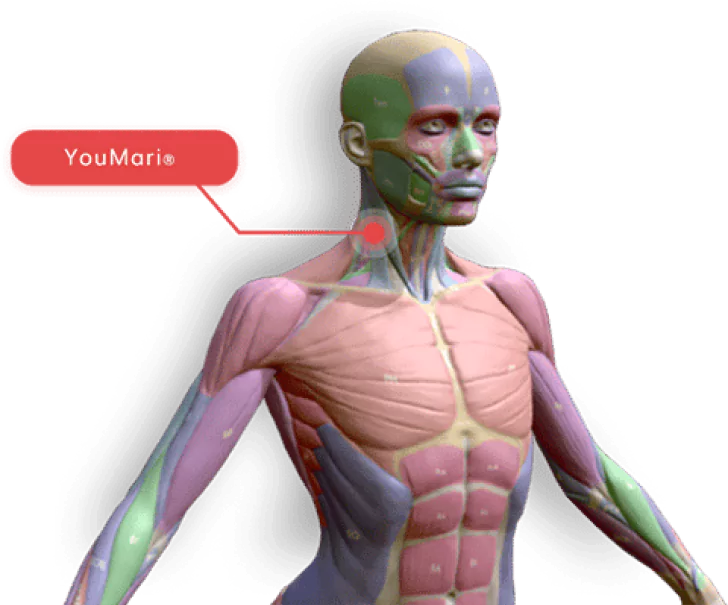Discover advanced therapies, tailored to your needs, that can be delivered in our clinics, at home, or onsite at your workplace.
Neck and shoulder pain are among the most common complaints, often caused by poor posture, repetitive stress, or injury. These areas are particularly prone to stiffness, inflammation, and reduced mobility due to their complex anatomy and frequent use in daily activities.Persistent neck and shoulder pain can significantly impact your quality of life, making it essential to address the root causes and promote long-term healing.

The glenohumeral joint, commonly referred to as the shoulder joint, is a remarkable structure that allows a wide range of motion in the upper limb. Pain in this region can stem from various causes, affecting the ball-and-socket joint where the upper arm bone (humerus) meets the shoulder blade (scapula).
The rotator cuff is a group of tendons and muscles that encircle and stabilize the shoulder joint. Injuries or inflammation in this area can lead to persistent shoulder pain and limited mobility.
Located at the top of the shoulder, the AC joint connects the clavicle (collarbone) to the acromion, a bony projection of the scapula. Pain and discomfort in this joint are common, particularly following injuries.
The scapulothoracic joint refers to the movement between the shoulder blade (scapula) and the ribcage. Dysfunctions in this joint can contribute to shoulder pain, affecting the stability and coordination of the shoulder.
Understanding the nuanced nature of shoulder pain, both in its acute and chronic forms, is pivotal for developing effective treatment strategies and alleviating the burden it places on individuals and society as a whole. Ongoing research endeavors seek to unravel the complexities of shoulder pain and enhance our ability to manage and mitigate its impact on those affected.

There are several common factors frequently associated with shoulder pain, which include:
Frozen Shoulder (Adhesive Capsulitis): This condition can lead to progressively increasing stiffness and pain, limiting your shoulder’s range of motion.
Shoulder Impingement: When your rotator cuff tendons get pinched within the shoulder joint, you might experience localized pain, especially during certain movements.
Arthritis: Both osteoarthritis and rheumatoid arthritis are well-known instigators of chronic shoulder pain, characterized by joint degeneration and inflammation.
These are the common suspects in the narrative of shoulder pain, each with its own unique story to tell. Recognizing their roles is the first step in finding the right treatment and relief for your specific shoulder pain scenario.
We understand that neck and shoulder pain can stem from tension, poor posture, injuries, or chronic conditions. Our advanced regenerative medicine therapies address the root causes by reducing inflammation, promoting healing, and restoring mobility.
Our unique approach combines non-invasive treatments that work synergistically to relieve pain and tension, helping you avoid invasive surgeries or long-term reliance on medications.

Experience hands-on care and advanced regenerative therapies in a relaxing, state-of-the-art environment.
Continue your healing journey with easy-to-use devices designed for at-home therapy.
Bring regenerative medicine to your workplace, improving employee health and productivity.
Our Regenerative Therapies our Not the Alternative, they are the
BEST CHOICE
We are committed to personalizing treatment plans based on what is best for every individual’s UNIQUE circumstances to include symptoms, budget, lifestyle, and goals. Conservative (non-surgical) care is effective in resolving pain and injuries most of the time.

In the realm of managing shoulder pain, our commitment to personalized treatment plans is firmly rooted in recent scholarly research. We embark on your treatment journey with a comprehensive evaluation, informed by the latest insights in shoulder pain management. This evaluation encompasses a meticulous review of your health history, a precise analysis of your specific symptoms, and a battery of functional movement tests. We may also utilize advanced 3D mobility health assessment tools, which have been supported by recent studies for their effectiveness in objectively measuring and establishing a baseline for assessing your shoulder’s range of motion and joint stability.
Our dedication to personalization aligns closely with recent research findings in the field of shoulder pain. When your condition qualifies for conservative care, we design a personalized treatment plan rooted in modalities that have demonstrated their effectiveness in recent scholarly articles and research. These modalities may encompass treatments like shockwave therapy, platelet-rich plasma (PRP) injections, light therapy, and fascial manipulation. We base our approach on data-driven decisions and provide you with multiple treatment plan options, complete with clear details about out-of-pocket costs.


Our approach to conservative care treatments is intricately linked to recent research specific to shoulder pain. Conservative treatments have been reported to lead to improvement or resolution in approximately 70-90% of individuals with shoulder pain. It’s important to note that the success rate can vary based on the underlying cause of the shoulder pain and the patient’s adherence to the treatment plan. This schedule typically spans 3 to 6 weeks, allowing ample time for healing between different treatment modalities.
Our decisions are firmly grounded in the most current science and research in the field of shoulder pain management. In cases where conservative care may not yield the desired results or your condition does not meet the criteria for such care, our distinguished medical director, a well-recognized figure in the field, personally conducts a comprehensive 90-minute evaluation. This evaluation is meticulously informed by recent scholarly insights and encompasses a detailed review of available imaging, resulting in an accurate diagnosis. This forms the basis for presenting you with personalized treatment plan options based on the latest advancements in medical research.


Our commitment to avoiding surgery is corroborated by recent research data specific to shoulder pain. We consistently achieve our goal of resolving pain, enhancing strength, and improving range of motion without the need for surgical intervention, as indicated by recent scholarly research. In the rare instances where surgery may be deemed necessary, rest assured that we guide you to identify a trusted surgeon with whom we have a strong professional relationship, ensuring that your specific shoulder injury and circumstances are effectively addressed. We operate as independent experts, with no financial incentives tied to surgical procedures, ensuring your best interests are always paramount.
Extracorporeal Shockwave Therapy (ESWT), also known as Pulsewave, is a breakthrough technology for stimulating healing of chronic pain and musculoskeletal injuries. ESWT is also referred to as PulseWave therapy. In simple terms, both use high-energy sound waves outside of the body to improve blood flow and initiate the bodies’ own healing processes. This is effective in both chronic and acute injuries. There has been significant, successful, research on the efficacy of ESWT for injuries.
Shockwaves can accelerate the healing process in the body, they stimulate metabolism and improve blood circulation; allowing damaged tissue to regenerate and fully heal. When properly applied, shockwave therapy can take a chronic condition Shoulder into the acute phase of healing. Chronic pain is caused by an incomplete healing process which must be disrupted (signaled) to be resolved (fully healed). ESWT has been used and studied in clinical applications since 1980, first emerging as a noninvasive procedure to breakup kidney stones. Treatment is noninvasive and virtually painless. The provider moves a handpiece around the pain zone and through the wand, low-energy shockwaves are transmitted into the body. The shockwaves stimulate metabolism and the blood circulation, breaking up scar tissues, and resulting in the body’s own healing processes being accelerated. Studies suggest that at least six shockwave treatments are necessary to see the positive results expressed in clinical studies.
Clinical Studies:
Platelets are small biological packages that normally circulate in the blood. They contain many growth factors. The growth factors promote healing by encouraging the growth of news blood vessels to help heal muscles, tendons, ligaments, and cartilage. This healing ability can be harnessed by drawing a small amount of your blood, placing it in a centrifuge to concentrate the platelets, and re-injecting the concentrated platelet-rich plasma (PRP) where your body needs help healing muscles, joints, or tendons. Because joint linings, tendons and ligaments receive very limited blood supply, injecting them with platelet-rich plasma can encourage the growth of new blood vessels and has been shown to accelerate healing and preventing the need for many surgeries.
The body’s ability to repair and replace damaged cartilage, tendon, or other specialized tissue in adults is limited. Injured joints or tendons can be a source of chronic pain and can limit activities. PRP therapy can harness the body’s own healing ability and resources to allow more complete healing than other alternatives. PRP is a natural treatment that uses only your own blood with no other additives.
Clinical Studies:
Fascial manipulation represents a wide array of scientifically-validated treatment techniques and models utilizing manual therapy that targets muscles and fascia in order to resolve pain, musculoskeletal injuries, and improve range of motion and strength. We utilize Functionally Optimized Massage ™ (FOM) which has effectively combined these techniques and models proven effective for specific injuries; however, no one technique has been proven effective on all 150 plus musculoskeletal conditions except our FOM.
FOM includes a comprehensive evaluation of the musculoskeletal system to identify range of motion and strength restrictions as well as pain reproducibility. We then direct treatment toward those fascial distortions, the root cause of the symptoms being experienced. With an aim to reduce these fascial distortions while improving motion control and strength. With improved movement, joints and adjacent soft tissues become relieved from the strain which leads to decreased pain as well as increased healing capability in soft tissue.
Clinical Studies:
Platelets are small biological packages that normally circulate in the blood. They contain many growth factors. The growth factors promote healing by encouraging the growth of news blood vessels to help heal muscles, tendons, ligaments, and cartilage. This healing ability can be harnessed by drawing a small amount of your blood, placing it in a centrifuge to concentrate the platelets, and re-injecting the concentrated platelet-rich plasma (PRP) where your body needs help healing muscles, joints, or tendons. Because joint linings, tendons and ligaments receive very limited blood supply, injecting them with platelet-rich plasma can encourage the growth of new blood vessels and has been shown to accelerate healing and preventing the need for many surgeries.
The body’s ability to repair and replace damaged cartilage, tendon, or other specialized tissue in adults is limited. Injured joints or tendons can be a source of chronic pain and can limit activities. PRP therapy can harness the body’s own healing ability and resources to allow more complete healing than other alternatives. PRP is a natural treatment that uses only your own blood with no other additives.
Clinical Studies:
“Based on the evidence synthesis there is Level III evidence for intradiscal injections of PRP and MSCs, whereas the evidence is considered Level IV for lumbar facet joint, lumbar epidural, and sacroiliac joint injections of PRP, (on a scale of Level I through V) using a qualitative modified approach to the grading of evidence based on best evidence synthesis.”https://pubmed.ncbi.nlm.nih.gov/30717500/
Inflammation can play a role in the development and exacerbation of Shoulder pain. When an injury or irritation occurs in the Shoulder, the body’s immune response triggers an inflammatory process as a protective mechanism. Inflammation involves the release of various chemicals and immune cells to the affected area, which can lead to pain, swelling, redness, and warmth. The goal of functional medicine testing is to identify and reduce inflammation sources to include food sensitivities, environmental pollutants, and allergies. An inflammatory response to an injury is exacerbated by diet and lifestyle choices causing inflammation that most patients are unaware of.
In the context of shoulder pain, inflammation can affect different structures, including the muscles, ligaments, tendons, and joints in the shoulder. Some ways in which inflammation can contribute to Shoulder pain are:
Shoulder pain can result from various causes, and it’s important to identify the underlying reason for proper treatment. Some of the most common causes of shoulder pain include:
It’s important to consult with a healthcare professional for a proper diagnosis if you are experiencing shoulder pain. Treatment options vary depending on the underlying cause, and an accurate diagnosis is crucial for effective management.
Self-treatment of shoulder pain can be effective for mild cases and temporary relief, but it’s important to keep in mind that the approach should be based on the cause of the pain. Here are some general self-care strategies to alleviate mild shoulder pain:
It’s important to note that these self-treatment methods are generally suitable for mild and short-term shoulder pain. If your pain is severe, persistent, or associated with other concerning symptoms, or if you’re unsure about the cause of your pain, it’s essential to seek professional medical advice. A healthcare provider can provide a proper diagnosis and recommend a personalized treatment plan, which may include physical therapy, medication, or other interventions based on the underlying condition.other symptoms like numbness, tingling, or weakness, it’s important to seek medical attention for a proper diagnosis and guidance on appropriate treatment options.
Preventing shoulder pain involves adopting a proactive approach to maintain shoulder health and reduce the risk of injuries. Here are some strategies to help prevent shoulder pain:
Remember that shoulder pain can have various causes, and these prevention strategies may not be effective for all conditions. If you experience persistent or severe shoulder pain, consult a healthcare provider for an accurate diagnosis and personalized treatment plan.
You should consider seeing a doctor for your shoulder pain in the following situations:
A healthcare provider, such as an orthopedic specialist or our patented 3D mobility assessment, can diagnose the cause of your shoulder pain and recommend an appropriate treatment plan. Early evaluation and intervention can prevent the worsening of shoulder conditions and improve your chances of a full recovery.
The treatment options for Shoulder pain depend on the underlying cause, severity of the pain, and individual circumstances. Here are some common treatment approaches:
It’s important to consult with a healthcare professional to determine the most appropriate treatment options based on the underlying cause of your Shoulder pain and your individual needs. They can provide a comprehensive evaluation, offer personalized recommendations, and guide you through the treatment process.
Yes, shoulder pain can be a sign of a more serious underlying condition. While many cases of shoulder pain are due to minor injuries or overuse, there are several serious medical conditions and causes that can manifest as shoulder pain. Some of these include:
It’s important to note that while these conditions can cause shoulder pain, most cases of shoulder pain are related to musculoskeletal issues, overuse, or minor injuries. If you experience severe or persistent shoulder pain or are concerned about your symptoms, it’s advisable to seek medical evaluation to rule out more serious underlying conditions. Early diagnosis and treatment can be crucial for these conditions. If you have concerns about your Shoulder pain or any associated symptoms, it’s recommended to consult with a BHS provider who can evaluate your condition, perform a thorough examination, and order any necessary tests to determine the underlying cause and provide appropriate treatment.
The duration of shoulder pain can vary widely depending on the underlying cause, the severity of the condition, and the effectiveness of treatment. Here’s a general guideline for how long shoulder pain may typically last for different causes:
It’s important to note that these are general guidelines, and individual experiences can vary. If your shoulder pain persists or worsens, it’s advisable to consult a healthcare provider for a proper diagnosis and treatment plan. Early intervention and adherence to treatment recommendations can help shorten the duration of shoulder pain and improve outcomes.
Yes, there are specific exercises and stretches that can help alleviate shoulder pain, depending on the underlying cause of the pain. It’s essential to consult with a healthcare provider or physical therapist to determine the most appropriate exercises for your condition. Here are some common exercises and stretches that may help with various types of shoulder pain:
Remember to start with gentle stretches and exercises and gradually increase intensity as your shoulder pain improves. If an exercise causes increased pain or discomfort, stop immediately and consult a healthcare provider. It’s essential to maintain proper form and consistency in your exercises and stretches for the best results.
The risk factors for developing shoulder pain can vary depending on the underlying causes and individual circumstances. However, some common risk factors associated with shoulder pain include:
It’s important to note that individual experiences and risk factors may vary, and some people may have multiple risk factors that contribute to their shoulder pain. Identifying and addressing these risk factors, along with proper medical guidance, can help prevent or manage shoulder pain effectively.
Yes, there are several lifestyle changes and habits you can adopt to help reduce shoulder pain and promote overall shoulder health. These lifestyle modifications can be especially effective if you’re dealing with chronic shoulder pain or aiming to prevent future issues. Here are some recommendations:
Remember that these lifestyle changes should be tailored to your specific needs and the underlying causes of your shoulder pain. If you’re experiencing persistent or severe shoulder pain, consult a BHS provider for a thorough evaluation and personalized recommendations.
Yes, stress and emotional factors can contribute to shoulder pain. The mind-body connection is a well-established phenomenon, and emotional stress can manifest physically in various ways, including muscle tension and pain in the shoulders and neck. Here’s how stress and emotions can impact shoulder pain:
Addressing stress and emotional factors is an important aspect of managing shoulder pain. Techniques to manage stress, such as relaxation exercises, mindfulness, meditation, and counseling, can be effective in reducing shoulder pain when it has an emotional component. Additionally, pain management strategies that take into account the mind-body connection, such as cognitive-behavioral therapy, can help individuals better cope with pain and stress. If you suspect that emotional factors are contributing to your shoulder pain, it’s advisable to consult a BHS provider or mental health.
There are ergonomic tips you can follow to maintain good posture and reduce Shoulder pain. Here are some recommendations:
It is important to adjust your ergonomic setup based on your individual needs and preferences. If you have specific concerns about your posture or shoulder pain, it’s advisable to consult with a healthcare professional or an ergonomic specialist who can provide personalized recommendations and further guidance.
Yes, certain occupations and activities are more likely to increase the risk of experiencing shoulder pain. These professions and activities often involve repetitive or strenuous movements that can strain the shoulder muscles and joints. Here are some examples:
It’s important for individuals in these occupations to be aware of the risks associated with their work and take preventive measures. This may include proper ergonomic training, regular breaks, and exercises to strengthen and maintain shoulder health. Additionally, using appropriate protective gear and lifting techniques can help reduce the likelihood of shoulder pain and injury.
While these occupations or activities may increase the likelihood of experiencing shoulder pain, it doesn’t mean that everyone in these roles will develop Shoulder pain. Proper body mechanics, ergonomic considerations, regular exercise, and taking breaks for stretching and movement can help reduce the risk of shoulder pain in these situations. If you have concerns about shoulder pain related to your occupation or activity, it’s recommended to consult with a healthcare professional or ergonomic specialist for personalized advice and guidance.
Chronic shoulder pain, if left untreated or unmanaged, can lead to various complications and long-term effects. It’s essential to address shoulder pain promptly to prevent these complications. Some potential complications and long-term effects of chronic shoulder pain include:
To prevent these complications and long-term effects, it’s crucial to seek appropriate medical care and consult with healthcare professionals who specialize in shoulder pain and musculoskeletal issues. They can develop a tailored treatment plan, which may include physical therapy, exercises, medications, injections, and in some cases, surgical interventions, to address the underlying causes of your shoulder pain and improve your overall shoulder health.
The insurance coverage for any treatment, including those for shoulder pain medicine, varies depending on several factors, including the insurance provider, the specific services or treatments being sought, and the healthcare provider’s credentials and billing practices. Here are a few points to consider:
To determine the insurance coverage for services, it is advisable to contact your insurance provider directly and inquire about the specific services or treatments you are considering. Additionally, you can reach out to BHS practitioners you are considering working with to discuss billing practices, insurance coverage, and potential reimbursement options.
Remember that insurance coverage can be complex and can vary widely, so it’s important to gather accurate and up-to-date information from both your insurance provider and the practitioner to make informed decisions about your healthcare and associated costs.
The cost of shoulder pain treatment can vary significantly depending on various factors, including the severity of the condition, the type of treatment required, geographical location, healthcare provider fees, insurance coverage, and any additional diagnostic tests or procedures. At BHS we prioritize the lowest cost and most effective treatment based on your symptoms and condition. Here are some common components that can contribute to the overall cost of Shoulder pain treatment:
It’s important to note that the cost of shoulder pain treatment can be significantly influenced by the healthcare system and insurance coverage in your country or region. Having health insurance coverage can help mitigate the out-of-pocket expenses, but specific coverage and reimbursement policies can vary.
To determine the exact cost of shoulder pain treatment, it is recommended to consult with BHS providers, and your primary care physicians, specialists, or insurance representatives, who can provide more specific information based on your individual circumstances. Knowing more information about treatment options and their associated costs will help you make an informed decision about your care.
There can be contraindications or situations where specific treatments for shoulder pain may not be advisable or require caution. It’s important to consult with a BHS provider to assess your individual condition and determine the most appropriate treatment options. Here are some general contraindications for certain Shoulder pain treatments:
For Conservative Care therapies:
For Medications:
For Injections or procedures:
For Surgical interventions:
Contraindications can vary depending on the specific treatment modality, individual health status, and other factors. Always consult with a healthcare professional who can evaluate your condition, review your medical history, and provide personalized recommendations regarding any potential contraindications for treating your Shoulder pain. They will be able to consider your specific circumstances and advise on the most appropriate and safe treatment options for you.
Neck and shoulder pain can result from various factors, including:
Our unique approach focuses on addressing the root causes of pain with advanced, non-invasive therapies. Instead of masking symptoms with medications or resorting to invasive surgeries, we use regenerative medicine to:
We tailor our treatments to your specific condition using the following therapies:
PBM uses specific wavelengths of light to penetrate deep into tissues. It reduces inflammation, eases muscle tension, and promotes cellular repair, making it ideal for chronic conditions or stress-related pain.
Hydrogen inhalation therapy provides systemic antioxidant benefits, neutralizing free radicals and reducing inflammation throughout the body. This helps alleviate chronic pain, improve mobility, and accelerate recovery from injuries.
Yes! ESWT improves blood flow and stimulates tissue healing, making it effective for treating muscle tightness, tendon injuries, and even chronic conditions like frozen shoulder.
HIFEM EMS uses focused electromagnetic energy to contract and strengthen the deep muscles that support the neck and shoulders. This not only relieves pain but also stabilizes the area to prevent future injuries.
Systemic inflammation often contributes to chronic pain and delayed healing. By reducing inflammation with therapies like H2 inhalation and PBM, we target the root causes of pain and accelerate your recovery process.
Yes, all our therapies are completely non-invasive and safe. They are scientifically validated, with no significant risks or downtime, making them ideal for patients of all ages.
Absolutely. Many patients turn to our therapies as an alternative to surgery or to reduce reliance on addictive pain medications. By addressing pain at its source, we aim to provide long-term relief without invasive procedures.
Our therapies are ideal for individuals experiencing:
Many patients experience noticeable relief after just a few sessions. However, the timeline depends on the severity of your condition and the combination of therapies used. Our personalized treatment plans are designed to deliver optimal results.
Yes! We offer at-home solutions like PBM and H2 devices, allowing you to continue your recovery conveniently and effectively.
Yes, we provide onsite therapies for employers looking to improve employee health. Our programs reduce pain caused by poor posture, repetitive movements, or workplace stress.
Getting started is easy! Book a consultation with our team to evaluate your condition and create a personalized plan tailored to your unique needs.
See Plans & Pricing

Connect with us over our social platforms & find special deals for you!
© Copyright 2025. All rights reserved.